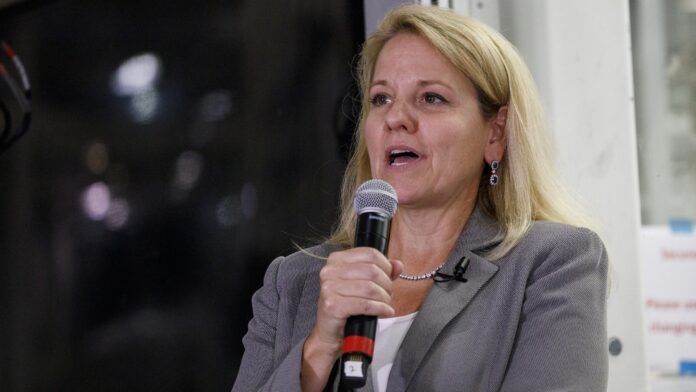SpaceX will light its biggest candle yet on Thursday when it stages a ground-bound “static fire” of the 33-engine first stage of its giant Starship rocket(Opens in a new window).
“Tomorrow is a big day for SpaceX,” President and COO Gwynne Shotwell said Wednesday at a space-industry event in Washington, D.C. “We are going to attempt a 33-engine static fire of the booster for Starship.”
SpaceX has staged previous static fires(Opens in a new window) of subsets of the Starship first stage’s complex complement of engines (four more than the 27 that light at launch on SpaceX’s Falcon Heavy, and one more than the 30 in the Soviet Union’s doomed N1 moon rocket(Opens in a new window)). SpaceX has to complete a full static fire before the orbital flight it now hopes to attempt in March.
“It’s really the final ground test we can do before we light ’em up and go,” Shotwell told her onstage interviewer, former Rep. Mike Rogers (R.-Ala.), at the Commercial Space Transportation Conference(Opens in a new window) hosted by the Commercial Spaceflight Federation(Opens in a new window) with the FAA.
A successful Starship launch will steal the “world’s most powerful rocket” title back from NASA’s Space Launch System, which had its own debut launch in November. NASA should not mind much, as it’s contracted with SpaceX to build a lunar lander based on Starship’s second stage for its SLS-launched Artemis program to return humans to the Moon.
SpaceX later aims to use Starship to send humans to Mars, and Rogers asked Shotwell for a forecast. “For sure this decade we will be landing people on the moon,” she replied. “Then Mars, hopefully this decade, maybe early next decade?”
A Flurry of Starlink Missions
In the near term, a successful Starship debut will lead to a flurry of missions to deploy SpaceX’s second-generation Starlink satellites. Shotwell called that a less risky way to keep testing Starship: “You want to be throwing your own stuff in orbit, so if you lose it you’re not disappointing a customer.”
As for Starlink itself, Shotwell called herself a happy customer of that low-Earth-orbit constellation of broadband satellites. She has five on her ranch, but she but did not address recent reports of the service slowing down in North America as more customers get online.
Calling Starlink “great for rural,” Shotwell pitched it as a more financially sound way to extend broadband than government-subsidized fiber buildouts.
Recommended by Our Editors
Rogers then asked about one of Starlink’s more interesting markets, Ukraine, where its compact dishes have become essential for both civil and military communication(Opens in a new window) as that country fights against Russia’s invasion.
“It was never intended to be weaponized,” Shotwell said of Starlink’s battlefield uses. “On the other hand, they are trying to fight for their country.”
Starlink has also been lining up customers in the air, in the form of airlines looking for faster and less laggy in-flight WiFi. Shotwell noted Starlink’s deals with Hawaiian Airlines and JSX (that luxe regional-jet operator is already flying with Starlink on board) but may or may not have unintentionally made news by name-dropping United Airlines onstage.
The conversation did not, however, touch on Shotwell’s boss Elon Musk and his chaotic stewardship of Twitter. Musk’s name only came up in roughly 30 minutes, when Shotwell said “Elon’s experience with Tesla” led him to want to see Starship built on a one-a-day cadence.
Get Our Best Stories!
Sign up for What’s New Now to get our top stories delivered to your inbox every morning.
This newsletter may contain advertising, deals, or affiliate links. Subscribing to a newsletter indicates your consent to our Terms of Use and Privacy Policy. You may unsubscribe from the newsletters at any time.
Hits: 0














